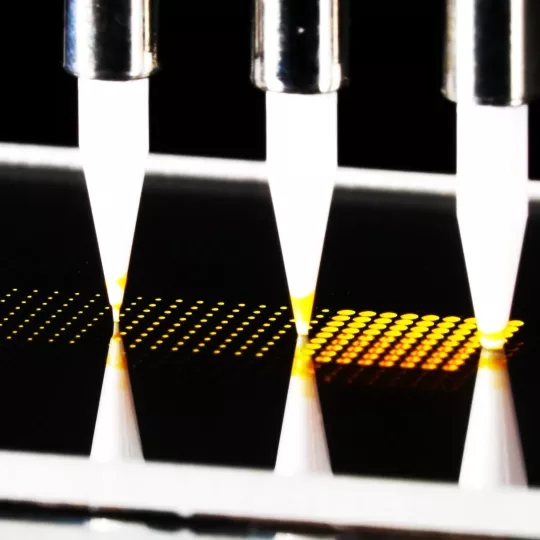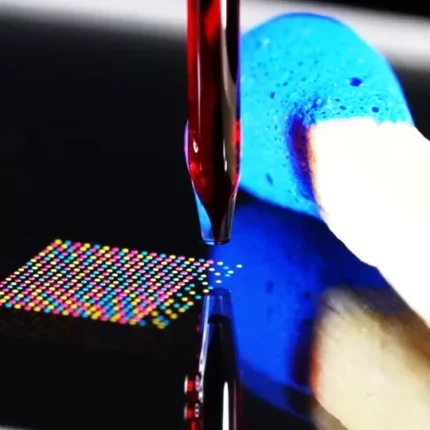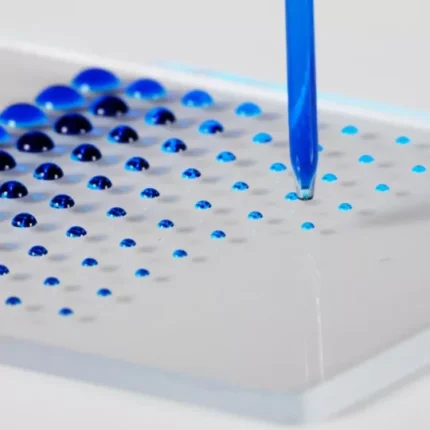- Bonder & Flip Chip
- Atmospheric Plasma Cleaner
- Vacuum Plasma Cleaner
- Spin Rinse Dryer
- Dispensing & Micro/Nano Printing System
- Lithography Process Systems
- Diffusion and LPCVD Furnaces
- Rapid Thermal Processing & Annealing
- Vacuum Soldering Systems
- Parylene Coating System
- Deposition System
- Hollow Cathode Plasma Source
- Plasma Etching System
- Sintering Presses
- Wet Process & Plating Tool
- Vacuum Chamber
- Electron Beam & Photo Resist
- Deposition Materials
Contact-based – Pico to Nanoliter Dispenser
ur contact-based Pin–Driven MicroDispensers (PinDMD) offer an advanced solution for microdispensing – a process integral to various scientific and industrial applications. These dispensers excel in transferring sample liquids through either blunt-end or capillary pins, creating suspended droplets at the blunt or tapered pin ends. Customization is a hallmark of this technology, with custom-specific pins available upon request. Moreover, our M2-standard pin-heads can accommodate up to 36 pins in a 6×6 arrangement.
Achieve unparalleled precision across an array of surfaces with our contact-based dispensing technology. This contact-based liquid-deposition approach ensures consistent and controlled liquid deposition for high-throughput applications. Whether you’re working with delicate membranes or conducting intricate experiments on glass slides, this technology excels in delivering accurate and reproducible results. The adaptability to microfluidic cartridges and 96-well plates further enhances its utility, making it an indispensable tool for a wide range of scientific and industrial applications.
The PinDMD can operate on our iTWO, iONE and iZERO microdispensing instruments.
Category: Dispenser Types
Tag: liquid deposition
Description
Key Features
- 36 pins per head (6x6)
- 4.5 mm dot-pitch
- capillary or blunt end pins available
- 80 µm to 500 µm tip diameter
- single droplet volume 350 pL to 25 nL
- absolute chemical inertness
Functional Principle
The process of contact printing relies on factors like target surface wettability, impacting liquid volume and process success.
As the dispensing tip approaches the substrate, the needle establishes contact, enabling conductive adhesive engagement. After reaching the optimal dispensing distance and a brief pause, the needle withdraws, leaving microdroplets on the surface due to adhesive forces and surface tension. This precise contact printing technology showcases the synergy between pin-based mechanics, liquid properties, and surface interactions.
Various Available Pin Types
Capillary pins feature tapered ends, leveraging surface tension and adhesive forces for controlled liquid transfer. Their significant advantage lies in enabling several hundred depositions with just one uptake step. In contrast, blunt-end pins possess flat terminations, excelling in precise, direct contact dispensing. Capillaries offer superior precision for small volumes, making them ideal for high-throughput applications. Blunt-end pins ensure consistent and direct liquid deposition. Both pin types contribute to the versatility required for diverse microdispensing tasks.
Different Volumes
Pin sizes act as conductors of transfer volumes, harmonizing with liquid surface tension and surface wetting intricacies. Explore our contact spotting technology, offering diameters ranging from 80 to 500 µm. This spectrum accommodates precise deposition of 0.5 to 30 nanoliter sample aliquots.
Diverse Layouts of Pin Heads
We understand that every research project is unique, and that's why we offer a range of pin-head layouts tailored to your specific requirements. Our standard pin head comes with a 6 x 6 configuration, with a 4.5 mm distance, ideal for working with a 384-well plate.
But we don't stop at "standard." We provide the flexibility to customize pin layouts to suit your project's precise needs. Whether you need a different well-plate configuration or have specific requirements, we're here to help you achieve your research goals. Explore our options and tailor your pin spotter to perfection.




